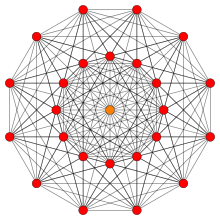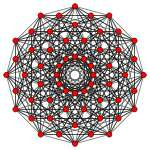6-polytope
 6-simplex |
 6-orthoplex, 311 |
 6-cube (Hexeract) |
 221 |
 Expanded 6-simplex |
 Rectified 6-orthoplex |
 6-demicube 131 (Demihexeract) |
 122 |
In six-dimensional geometry, a six-dimensional polytope or 6-polytope is a polytope, bounded by 5-polytope facets.
Definition
A 6-polytope is a closed six-dimensional figure with vertices, edges, faces, cells (3-faces), 4-faces, and 5-faces. A vertex is a point where six or more edges meet. An edge is a line segment where four or more faces meet, and a face is a polygon where three or more cells meet. A cell is a polyhedron. A 4-face is a polychoron, and a 5-face is a 5-polytope. Furthermore, the following requirements must be met:
- Each 4-face must join exactly two 5-faces (facets).
- Adjacent facets are not in the same five-dimensional hyperplane.
- The figure is not a compound of other figures which meet the requirements.
Characteristics
The topology of any given 6-polytope is defined by its Betti numbers and torsion coefficients.[1]
The value of the Euler characteristic used to characterise polyhedra does not generalize usefully to higher dimensions, and is zero for all 6-polytopes, whatever their underlying topology. This inadequacy of the Euler characteristic to reliably distinguish between different topologies in higher dimensions led to the discovery of the more sophisticated Betti numbers.[1]
Similarly, the notion of orientability of a polyhedron is insufficient to characterise the surface twistings of toroidal polytopes, and this led to the use of torsion coefficients.[1]
Classification
6-polytopes may be classified by properties like "convexity" and "symmetry".
- A 6-polytope is convex if its boundary (including its 5-faces, 4-faces, cells, faces and edges) does not intersect itself and the line segment joining any two points of the 6-polytope is contained in the 6-polytope or its interior; otherwise, it is non-convex. Self-intersecting 6-polytope are also known as star 6-polytopes, from analogy with the star-like shapes of the non-convex Kepler-Poinsot polyhedra.
- A regular 6-polytope has all identical regular 5-polytope facets. All regular 6-polytope are convex.
- A semi-regular 6-polytope contains two or more types of regular 4-polytope facets. There is only one such figure, called 221.
- A uniform 6-polytope has a symmetry group under which all vertices are equivalent, and its facets are uniform 5-polytopes. The faces of a uniform polytope must be regular.
- A prismatic 6-polytope is constructed by the Cartesian product of two lower-dimensional polytopes. A prismatic 6-polytope is uniform if its factors are uniform. The 6-cube is prismatic (product of a squares and a cube), but is considered separately because it has symmetries other than those inherited from its factors.
- A 5-space tessellation is the division of five-dimensional Euclidean space into a regular grid of 5-polytope facets. Strictly speaking, tessellations are not 6-polytopes as they do not bound a "6D" volume, but we include them here for the sake of completeness because they are similar in many ways to 6-polytope. A uniform 5-space tessellation is one whose vertices are related by a space group and whose facets are uniform 5-polytopes.
Regular 6-polytopes
Regular 6-polytopes can be generated from Coxeter groups represented by the Schläfli symbol {p,q,r,s,t} with t {p,q,r,s} 5-polytope facets around each cell.
There are only three such convex regular 6-polytopes:
- {3,3,3,3,3} - 6-simplex
- {4,3,3,3,3} - 6-cube
- {3,3,3,3,4} - 6-orthoplex
There are no nonconvex regular polytopes of 5 or more dimensions.
For the 3 convex regular 6-polytopes, their elements are:
| Name | Schläfli symbol | Coxeter diagram | Vertices | Edges | Faces | Cells | 4-faces | 5-faces | Symmetry (order) |
|---|---|---|---|---|---|---|---|---|---|
| 6-simplex | {3,3,3,3,3} | 7 | 21 | 35 | 35 | 21 | 7 | A6 (720) | |
| 6-orthoplex | {3,3,3,3,4} | 12 | 60 | 160 | 240 | 192 | 64 | B6 (46080) | |
| 6-cube | {4,3,3,3,3} | 64 | 192 | 240 | 160 | 60 | 12 | B6 (46080) |
Uniform 6-polytopes
Here are six simple uniform convex 6-polytopes, including the 6-orthoplex repeated with its alternate construction.
| Name | Schläfli symbol(s) | Coxeter diagram(s) | Vertices | Edges | Faces | Cells | 4-faces | 5-faces | Symmetry (order) |
|---|---|---|---|---|---|---|---|---|---|
| Expanded 6-simplex | t0,5{3,3,3,3,3} | 42 | 210 | 490 | 630 | 434 | 126 | 2×A6 (1440) | |
| 6-orthoplex, 311 (alternate construction) | {3,3,3,31,1} | 12 | 60 | 160 | 240 | 192 | 64 | D6 (23040) | |
| 6-demicube | {3,33,1} h{4,3,3,3,3} | 32 | 240 | 640 | 640 | 252 | 44 | D6 (23040) ½B6 | |
| Rectified 6-orthoplex | t1{3,3,3,3,4} t1{3,3,3,31,1} | 60 | 480 | 1120 | 1200 | 576 | 76 | B6 (46080) 2×D6 | |
| 221 polytope | {3,3,32,1} | 27 | 216 | 720 | 1080 | 648 | 99 | E6 (51840) | |
| 122 polytope | {3,32,2} | or | 72 | 720 | 2160 | 2160 | 702 | 54 | 2×E6 (103680) |
The expanded 6-simplex is the vertex figure of the uniform 6-simplex honeycomb, ![]()
![]()
![]()
![]()
![]()
![]()
![]() . The 6-demicube honeycomb,
. The 6-demicube honeycomb, ![]()
![]()
![]()
![]()
![]()
![]()
![]()
![]()
![]() , vertex figure is a rectified 6-orthoplex and facets are the 6-orthoplex and 6-demicube. The uniform 222 honeycomb,
, vertex figure is a rectified 6-orthoplex and facets are the 6-orthoplex and 6-demicube. The uniform 222 honeycomb,![]()
![]()
![]()
![]()
![]()
![]()
![]()
![]()
![]() , has 122 polytope is the vertex figure and 221 facets.
, has 122 polytope is the vertex figure and 221 facets.
References
- T. Gosset: On the Regular and Semi-Regular Figures in Space of n Dimensions, Messenger of Mathematics, Macmillan, 1900
- A. Boole Stott: Geometrical deduction of semiregular from regular polytopes and space fillings, Verhandelingen of the Koninklijke academy van Wetenschappen width unit Amsterdam, Eerste Sectie 11,1, Amsterdam, 1910
- H.S.M. Coxeter:
- H.S.M. Coxeter, M.S. Longuet-Higgins und J.C.P. Miller: Uniform Polyhedra, Philosophical Transactions of the Royal Society of London, Londne, 1954
- H.S.M. Coxeter, Regular Polytopes, 3rd Edition, Dover New York, 1973
- Kaleidoscopes: Selected Writings of H.S.M. Coxeter, edited by F. Arthur Sherk, Peter McMullen, Anthony C. Thompson, Asia Ivic Weiss, Wiley-Interscience Publication, 1995, ISBN 978-0-471-01003-6
- (Paper 22) H.S.M. Coxeter, Regular and Semi Regular Polytopes I, [Math. Zeit. 46 (1940) 380-407, MR 2,10]
- (Paper 23) H.S.M. Coxeter, Regular and Semi-Regular Polytopes II, [Math. Zeit. 188 (1985) 559-591]
- (Paper 24) H.S.M. Coxeter, Regular and Semi-Regular Polytopes III, [Math. Zeit. 200 (1988) 3-45]
- N.W. Johnson: The Theory of Uniform Polytopes and Honeycombs, Ph.D. Dissertation, University of Toronto, 1966
- Klitzing, Richard. "6D uniform polytopes (polypeta)".
External links
- Polytope names
- Polytopes of Various Dimensions, Jonathan Bowers
- Multi-dimensional Glossary
- Glossary for hyperspace, George Olshevsky.
| Fundamental convex regular and uniform polytopes in dimensions 2–10 | ||||||||||||
|---|---|---|---|---|---|---|---|---|---|---|---|---|
| Family | An | Bn | I2(p) / Dn | E6 / E7 / E8 / E9 / E10 / F4 / G2 | Hn | |||||||
| Regular polygon | Triangle | Square | p-gon | Hexagon | Pentagon | |||||||
| Uniform polyhedron | Tetrahedron | Octahedron • Cube | Demicube | Dodecahedron • Icosahedron | ||||||||
| Uniform 4-polytope | 5-cell | 16-cell • Tesseract | Demitesseract | 24-cell | 120-cell • 600-cell | |||||||
| Uniform 5-polytope | 5-simplex | 5-orthoplex • 5-cube | 5-demicube | |||||||||
| Uniform 6-polytope | 6-simplex | 6-orthoplex • 6-cube | 6-demicube | 122 • 221 | ||||||||
| Uniform 7-polytope | 7-simplex | 7-orthoplex • 7-cube | 7-demicube | 132 • 231 • 321 | ||||||||
| Uniform 8-polytope | 8-simplex | 8-orthoplex • 8-cube | 8-demicube | 142 • 241 • 421 | ||||||||
| Uniform 9-polytope | 9-simplex | 9-orthoplex • 9-cube | 9-demicube | |||||||||
| Uniform 10-polytope | 10-simplex | 10-orthoplex • 10-cube | 10-demicube | |||||||||
| Uniform n-polytope | n-simplex | n-orthoplex • n-cube | n-demicube | 1k2 • 2k1 • k21 | n-pentagonal polytope | |||||||
| Topics: Polytope families • Regular polytope • List of regular polytopes and compounds | ||||||||||||